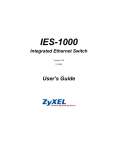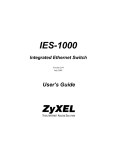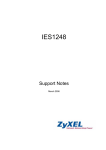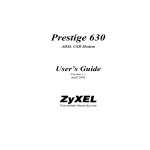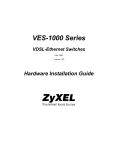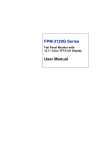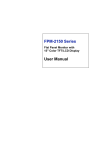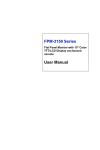Download ZyXEL Communications IES-1000 Installation guide
Transcript
IES-1000 Integrated Ethernet Switch July 2002 Version 2.04 Hardware Installation Guide IES-1000 Hardware Installation Guide Copyright IES-1000 Integrated Ethernet Switch Copyright © 2002 by ZyXEL Communications Corporation. The contents of this publication may not be reproduced in any part or as a whole, transcribed, stored in a retrieval system, translated into any language, or transmitted in any form or by any means, electronic, mechanical, magnetic, optical, chemical, photocopying, manual, or otherwise, without the prior written permission of ZyXEL Communications Corporation. Published by ZyXEL Communications Corporation. All rights reserved. Disclaimer ZyXEL does not assume any liability arising out of the application or use of any products, or software described herein. Neither does it convey any license under its patent rights nor the patent rights of others. ZyXEL further reserves the right to make changes in any products described herein without notice. This publication is subject to change without notice. Trademarks Trademarks mentioned in this publication are used for identification purposes only and may be properties of their respective owners. ii Copyright IES-1000 Hardware Installation Guide ZyXEL Limited Warranty ZyXEL warrants to the original end user (purchaser) that this product is free from any defects in materials or workmanship for a period of up to two (2) years from the date of purchase. During the warranty period and upon proof of purchase, should the product have indications of failure due to faulty workmanship and/or materials, ZyXEL will, at its discretion, repair or replace the defective products or components without charge for either parts or labor and to whatever extent it shall deem necessary to restore the product or components to proper operating condition. Any replacement will consist of a new or re-manufactured functionally equivalent product of equal value, and will be solely at the discretion of ZyXEL. This warranty shall not apply if the product is modified, misused, tampered with, damaged by an act of God, or subjected to abnormal working conditions. Note Repair or replacement, as provided under this warranty, is the exclusive remedy of the purchaser. This warranty is in lieu of all other warranties, express or implied, including any implied warranty of merchantability or fitness for a particular use or purpose. ZyXEL shall in no event be held liable for indirect or consequential damages of any kind of character to the purchaser. To obtain the services of this warranty, contact ZyXEL's Service Center for your Return Material Authorization number (RMA). Products must be returned Postage Prepaid. It is recommended that the unit be insured when shipped. Any returned products without proof of purchase or those with an out-dated warranty will be repaired or replaced (at the discretion of ZyXEL) and the customer will be billed for parts and labor. All repaired or replaced products will be shipped by ZyXEL to the corresponding return address, Postage Paid. This warranty gives you specific legal rights, and you may also have other rights that vary from country to country. ZyXEL Limited Warranty iii IES-1000 Hardware Installation Guide Customer Support If you have questions about your ZyXEL product or desire assistance, contact ZyXEL Communications Corporation offices worldwide, in one of the following ways: Contacting Customer Support When you contact your customer support representative, have the following information ready: ♦ Model and serial number. ♦ Warranty information. ♦ Date you received your product. ♦ Brief description of the problem and the steps you took to solve it. METHOD E-MAIL SUPPORT/SALES TELEPHONE/FAX WEB SITE/ FTP SITE REGULAR MAIL LOCATION WORLDWIDE [email protected] +886-3-578-3942 www.zyxel.com www.europe.zyxel.com [email protected] +886-3-578-2439 ftp.europe.zyxel.com [email protected] +1-714-632-0882 800-255-4101 www.zyxel.com [email protected] +1-714-632-0858 ftp.zyxel.com SCANDINAVIA [email protected] +45-3955-0700 www.zyxel.dk [email protected] +45-3955-0707 ftp.zyxel.dk GERMANY [email protected] +49-2405-6909-0 www.zyxel.de [email protected] +49-2405-6909-99 ZyXEL Deutschland GmbH. Adenauerstr. 20/A4 D-52146 Wuerselen, Germany [email protected] +603-795-44-688 www.zyxel.com.my [email protected] +603-795-34-407 Lot B2-06, PJ Industrial Park, Section 13, Jalan Kemajuan, 46200 Petaling Jaya Selangor Darul Ehasn, Malaysia NORTH AMERICA MALAYSIA iv ZyXEL Communications Corp., 6 Innovation Road II, ScienceBased Industrial Park, Hsinchu, 300 Taiwan ZyXEL Communications Inc., 1650 Miraloma Avenue, Placentia, CA 92870, U.S.A. ZyXEL Communications A/S, Columbusvej 5, 2860 Soeborg, Denmark Customer Support IES-1000 Hardware Installation Guide Table of Contents Copyright .................................................................................................................................................................... ii ZyXEL Limited Warranty ....................................................................................................................................... iii Customer Support..................................................................................................................................................... iv List of Figures........................................................................................................................................................... vii List of Tables ............................................................................................................................................................ vii Preface...................................................................................................................................................................... viii Chapter 1 IES-1000 Applications..................................................................................................................... 1-1 1.1 Applications .............................................................................................................................................. 1-1 1.1.1 MTU Application .............................................................................................................................. 1-1 1.1.2 Enterprise Application....................................................................................................................... 1-2 Chapter 2 Hardware Installation..................................................................................................................... 2-1 2.1 Environment.............................................................................................................................................. 2-1 2.1.1 Operating Environment ..................................................................................................................... 2-1 2.1.2 Storage Environment......................................................................................................................... 2-1 2.2 Free-standing IES-1000 Installation Requirements .................................................................................. 2-1 2.3 Rack-mounted IES-1000 Installation Requirements ................................................................................. 2-1 2.4 Mounting the IES-1000 on a Rack ............................................................................................................ 2-1 2.4.1 Attaching the Mounting Brackets to the IES-1000 ........................................................................... 2-2 2.4.2 Mounting the IES-1000 on a Rack .................................................................................................... 2-2 Chapter 3 Removing and Installing Network Modules ................................................................................. 3-1 3.1 Removing a G.SHDSL SAM1008 Network Module................................................................................. 3-1 3.2 Installing a Network Module..................................................................................................................... 3-2 Chapter 4 IES-1000 Connections ..................................................................................................................... 4-1 4.1 Front Panel Connections ........................................................................................................................... 4-1 4.2 Console Port .............................................................................................................................................. 4-1 4.3 SHDSL Port Connections.......................................................................................................................... 4-2 4.3.1 Procedure to Complete a G.SHDSL Connection .............................................................................. 4-2 Notes About MDFs (Main Distribution Frames) .......................................................................................... 4-4 4.4 ADSL Port Connections............................................................................................................................ 4-5 4.4.1 Typical Scenarios .............................................................................................................................. 4-6 4.4.2 Installation Scenario A ...................................................................................................................... 4-6 Procedure To Connect To An MDF.............................................................................................................. 4-7 4.4.3 Installation Scenario B ...................................................................................................................... 4-7 Procedure To Connect To MDFs .................................................................................................................. 4-9 4.4.4 Installation Scenario C .................................................................................................................... 4-10 Procedure To Connect To MDFs ................................................................................................................ 4-11 4.4.5 LAN Port (Ethernet) Connection .................................................................................................... 4-12 4.4.6 Power Cord...................................................................................................................................... 4-12 Chapter 5 Turning On Your IES-1000............................................................................................................ 5-1 5.1 Introduction ............................................................................................................................................... 5-1 5.2 Network Module Front Panel LEDs.......................................................................................................... 5-2 Chapter 6 Hardware Troubleshooting ............................................................................................................ 6-1 Table of Contents v IES-1000 Hardware Installation Guide 6.1 System Startup...........................................................................................................................................6-1 6.1.1 The SYS LED Does Not Turn On .....................................................................................................6-1 6.2 The ALM LED Is On.................................................................................................................................6-1 6.3 The SHDSL LED(s) Do Not Turn On .......................................................................................................6-2 6.4 The ADSL LED(s) Do Not Turn On..........................................................................................................6-2 6.5 The LAN LED(s) Do Not Turn On ...........................................................................................................6-3 6.6 There Is No Voice on an ADSL Connection..............................................................................................6-3 Appendix A Removing and Installing a Fuse.......................................................................................................... A Appendix B Pin Assignments ................................................................................................................................... D Appendix C Hardware Specifications ......................................................................................................................F Index .............................................................................................................................................................................I vi Table of Contents IES-1000 Hardware Installation Guide List of Figures Figure 1-1 IES-1000 Building Deployment Example............................................................................................... 1-2 Figure 1-2 Enterprise Application ............................................................................................................................. 1-3 Figure 2-1 Attaching the Mounting Brackets to the IES-1000.................................................................................. 2-2 Figure 2-2 Mounting the IES-1000 on a Rack .......................................................................................................... 2-3 Figure 3-1 The IES-1000 G.SHDSL SAM1008 Network Module............................................................................ 3-1 Figure 3-2 Loosen Module Screws ........................................................................................................................... 3-1 Figure 3-3 Removing a Network Module from the IES-1000 Chassis ..................................................................... 3-2 Figure 3-4 Installing a Network Module into the IES-1000 Chassis ........................................................................ 3-3 Figure 3-5 Tighten Module Screws........................................................................................................................... 3-3 Figure 4-1 SAM1008 Front Panel Connections Overview ....................................................................................... 4-1 Figure 4-2 Console Port Connection......................................................................................................................... 4-2 Figure 4-3 SHDSL Port and MDF Connections ....................................................................................................... 4-3 Figure 4-4 SHDSL Port, MDF and User Equipment Connections............................................................................ 4-4 Figure 4-5 Magnified View of MDF Wiring ............................................................................................................. 4-5 Figure 4-6 AAM1008 Installation Overview ............................................................................................................ 4-6 Figure 4-7 Installation Scenario A ............................................................................................................................ 4-7 Figure 4-8 One MDF for End-user and CO Connections ......................................................................................... 4-8 Figure 4-9 Installation Scenario B ............................................................................................................................ 4-9 Figure 4-10 Two Separate MDFs for End-user and CO Connections..................................................................... 4-10 Figure 4-11 Installation Scenario C......................................................................................................................... 4-11 Figure 4-12 Stacking Multiple IES-1000 Units ...................................................................................................... 4-12 Figure 4-13 Connecting the Power Cord to the IES-1000 and a Power Source...................................................... 4-13 Figure 5-1 Location of the IES-1000 Fans................................................................................................................ 5-1 Figure 5-2 SAM1008 Front Panel LEDs................................................................................................................... 5-2 Figure 5-3 AAM1008 Front Panel LEDs .................................................................................................................. 5-2 List of Tables Table 5-1 Network Module LED Descriptions ......................................................................................................... 5-2 Table 6-1 SYS LED Troubleshooting ....................................................................................................................... 6-1 Table 6-2 ALM LED Troubleshooting ...................................................................................................................... 6-1 Table 6-3 SHDSL LED Troubleshooting .................................................................................................................. 6-2 Table 6-4 ADSL LED Troubleshooting..................................................................................................................... 6-2 Table 6-5 LAN LED Troubleshooting ...................................................................................................................... 6-3 Table 6-6 ADSL Voice Troubleshooting ................................................................................................................... 6-3 List of Diagrams Diagram 1 Removing the Power Cord .........................................................................................................................A Diagram 2 Opening the Fuse Housing .........................................................................................................................B Diagram 3 Locations of the Installed and Spare Fuses ................................................................................................C Diagram 4 RJ-11 4P4C (Console Port) Pin Assignments ............................................................................................D Diagram 5 RJ-11 6P2C (SHDSL Port) Pin Assignments .............................................................................................D Diagram 6 RJ-45 (LAN Port) Pin Assignments ........................................................................................................... E Lists of Figures, Diagrams and Tables vii IES-1000 Hardware Installation Guide Preface Congratulations on your purchase of the IES-1000 Integrated Ethernet switch. This guide shows you how to set up the hardware for your IES-1000. About the IES-1000 The IES-1000 is an integrated Ethernet switch that multiplexes traffic from up to 16 G.SHDSL or ADSL subscribers (or eight of each) into two 10/100M Ethernet ports that connect to a WAN network via a WAN switch. Syntax Conventions “Enter” means for you to type one or more characters and press the carriage return. “Select” or “Choose” means for you to select one from the predefined choices. For brevity’s sake, we will use “e.g.” as shorthand for “for instance”, and “i.e.” as shorthand for “that is” or “in other words” throughout this manual. Related Documentation User’s Guide The User’s Guide explains firmware setup, management and maintenance procedures. Glossary and ZyXEL Web Site Please refer to www.zyxel.com for an online glossary of networking terms or the ZyXEL download library for additional support documentation. viii Preface IES-1000 Hardware Installation Guide Chapter 1 IES-1000 Applications This chapter describes IES-1000 applications and basic operating environment. 1.1 Applications The following are typical DSL multiplexing applications of the IES-1000. 1. Multiple Tenant Unit (MTU) 2. Enterprise 1.1.1 MTU Application The following figure depicts a typical application of the IES-1000 in a large residential building, or Multiple Tenant Unit (MTU), that leverages existing phone line wiring to provide Internet access to all tenants. A tenant connects a computer to the phone line in a unit using a G.SHDSL or ADSL modem. The other end of the phone line is connected to a port on the IES-1000. The IES-1000 aggregates the traffic from the tenants to the Ethernet port and forwards it to a router or switch. The router (or switch) then routes the traffic further to the Internet. IES-1000 Applications 1-1 IES-1000 Hardware Installation Guide Figure 1-1 IES-1000 Building Deployment Example 1.1.2 Enterprise Application The IES-1000 can also be used in any-sized company to multiplex traffic from employee G.SHDSL or ADSL connections to the Internet. Multiplex traffic from up to 16 connections and use a hub or switch to multiplex more. 1-2 IES-1000 Applications IES-1000 Hardware Installation Guide Figure 1-2 Enterprise Application IES-1000 Applications 1-3 IES-1000 Hardware Installation Guide Chapter 2 Hardware Installation This chapter shows you how to install hardware for a free-standing or rack-mounted scenario. 2.1 Environment The following are the recommended environments for the IES-1000. 2.1.1 Operating Environment Temperature: 0 — 50°C; Humidity: 5% — 95% (non-condensing) 2.1.2 Storage Environment Temperature: -25 - 70°C; Humidity: 5% - 95% (non-condensing) Refer also to the Hardware Specification Appendix. 2.2 Free-standing IES-1000 Installation Requirements Position the IES-1000 on a flat surface. Remember that the unit requires proper ventilation. 2.3 Rack-mounted IES-1000 Installation Requirements • Two mounting brackets (supplied). • Eight M3 flat head screws (supplied) and a #2 Philips screwdriver. • Four M5 flat head screws and a #2 Philips screwdriver. 2.4 Mounting the IES-1000 on a Rack Precautions: • Make sure the rack will safely support the combined weight of all the equipment it contains. • Make sure the position of the IES-1000 does not make the rack unstable or top-heavy. Take all necessary precautions to anchor the rack securely before installing the unit. Hardware Installation 2-1 IES-1000 Hardware Installation Guide 2.4.1 Step 1. Attaching the Mounting Brackets to the IES-1000 Position a mounting bracket on one side of the IES-1000, lining up the four screw holes on the bracket with the screw holes on the side of the unit (see the figure shown next). Failure to use the proper screws may damage the unit. Figure 2-1 Attaching the Mounting Brackets to the IES-1000 Step 2. Using a #2 Philips screwdriver, install the M3 flat head screws that came with the brackets through the mounting bracket holes into the IES-1000. Step 3. Repeat Step 1 and Step 2 to install the second mounting bracket on the other side of the unit. You may now mount the IES-1000 on a rack. Proceed to the next section. 2.4.2 Step 1. Mounting the IES-1000 on a Rack Position a mounting bracket (that is already attached to the IES-1000) on one side of the rack, lining up the two screw holes on the bracket with the screw holes on the side of the rack (see the figure shown next). Failure to use the proper screws may damage the unit. 2-2 Hardware Installation IES-1000 Hardware Installation Guide Figure 2-2 Mounting the IES-1000 on a Rack Step 2. Using a #2 Philips screwdriver, install the M5 flat head screws through the mounting bracket holes into the rack. Step 3. Repeat Step 1 and Step 2 to attach the second mounting bracket on the other side of the rack. Hardware Installation 2-3 IES-1000 Hardware Installation Guide Chapter 3 Removing and Installing Network Modules This chapter shows you how to remove and install network modules. Each IES-1000 accommodates up to two network modules. Remove and install modules via the front of the IES1000. The figure below shows the front view of a SAM1008 network module; the procedures for removing and installing AAM1008 network modules are the same. Figure 3-1 The IES-1000 G.SHDSL SAM1008 Network Module 3.1 Step 1. Removing a G.SHDSL SAM1008 Network Module Loosen the two screws on the front panel that secure the module to the chassis by turning them counterclockwise as show next. Figure 3-2 Loosen Module Screws Step 2. Gently pull the network module out of the chassis as shown next. Removing and Installing Network Modules 3-1 IES-1000 Hardware Installation Guide Figure 3-3 Removing a Network Module from the IES-1000 Chassis 3.2 Installing a Network Module Step 1. Hold the module with the network ports facing you and insert it into an empty slot located on the front of the IES-1000 as shown next. Step 2. Push the bottom of the front of the module into the IES-1000. The front of the module should be flush with the IES-1000 chassis. 3-2 Removing and Installing Network Modules IES-1000 Hardware Installation Guide Figure 3-4 Installing a Network Module into the IES-1000 Chassis The front of the network module must be flush with the front of the IES-1000 after you install a network module or it will not work! Step 3. Secure the module to the chassis by turning the two screws on the front of the module clockwise as shown next. Figure 3-5 Tighten Module Screws Removing and Installing Network Modules 3-3 IES-1000 Hardware Installation Guide Chapter 4 IES-1000 Connections This chapter shows you how and where to make hardware connections. Before you make your hardware connections, make sure that your IES-1000 is safely and securely positioned. 4.1 Front Panel Connections All connections are made on the front panel of the IES-1000. The following figure shows the front panel connections of the SAM1008. A more detailed discussion follows. Connections for the AAM1008 are the same except for the DSL ports (see 4.4 for details). Figure 4-1 SAM1008 Front Panel Connections Overview 4.2 Console Port For the initial configuration, you need to use terminal emulator software on a computer and connect it to a network module through the console port. Connect the mini-RJ-11 end of the console cable to the console port of the network module. Connect the other end to a serial port of your computer. After the initial setup, you can modify the configuration remotely through Telnet connections. Hardware Connections 4-1 IES-1000 Hardware Installation Guide Figure 4-2 Console Port Connection 4.3 SHDSL Port Connections The SHDSL ports connect to an MDF (Main Distribution Frame) and end-user equipment via telephone wire. • For detailed specifications about the associated RJ-11 connector, refer to the Pin Assignment appendix. • For more detail about MDF connections refer to the Notes About MDFs (Main Distribution Frames) shown later in this section. The procedure shown next explains how to complete a single G.SHDSL connection (SAM1008) to an MDF via an SHDSL port. Instructions on ADSL connections (AAM1008) come later. 4.3.1 Procedure to Complete a G.SHDSL Connection Step 1. Connect the RJ-11 end of a telephone wire to the SHDSL port on the front panel of the SAM1008 as shown next. Step 2. Connect the other end of the telephone wire to the upper port of an MDF (Main Distribution Frame) using a punch-down tool. 4-2 Hardware Connections IES-1000 Hardware Installation Guide Figure 4-3 SHDSL Port and MDF Connections Step 3. Connect a different telephone wire to the lower port of the MDF using a punch-down tool. Step 4. Connect the other (RJ-11) end of the telephone wire to the end-user G.SHDSL modem/router. When you finish this procedure your connections should look similar to the figure shown next. Connections between the user’s computer and modem/router are not described here. Hardware Connections 4-3 IES-1000 Hardware Installation Guide Figure 4-4 SHDSL Port, MDF and User Equipment Connections Notes About MDFs (Main Distribution Frames) An MDF is usually installed between end-users’ equipment and the telephone company (CO) in a basement or telephone room. The MDF is the point of termination for the outside telephone company lines coming into a building and the telephone lines in the building. 4-4 Hardware Connections IES-1000 Hardware Installation Guide Figure 4-5 Magnified View of MDF Wiring Connect wiring from end-user equipment to the lower ports of an MDF using a telephone wire. Connect wiring from the telephone company to the upper ports of an MDF (see the previous figure). Some MDFs have surge protection circuitry built in between the two banks; thus, do not connect telephone wires from the telephone company directly to the IES-1000. Use a punch-down tool to seat telephone lines between MDF blocks. This chapter details how to connect ADSL wiring to MDFs based on your existing telephone wiring infrastructure. 4.4 ADSL Port Connections The AAM1008 network module can provide ADSL and voice services over the same telephone wiring. It also has built in splitters that save space and simplify installation. The following figure gives an example of a basic installation scenario for using the AAM1008 to combine voice and data signals. Hardware Connections 4-5 IES-1000 Hardware Installation Guide Figure 4-6 AAM1008 Installation Overview You can also use RJ-11 connectors on both ends of the telephone cables connect directly to an ADSL modem(s) or patch panel. This chapter discusses connections using MDFs. 4.4.1 Typical Scenarios Your existing telephone wiring usually depends on your region. Here are descriptions of three typical installation scenarios. See the Notes About MDFs (Main Distribution Frames) for more information about MDFs. Use telephone wires with RJ-11 jacks on one end (follow the pin assignments shown in the Pin Assignments Appendix) for connecting to the AAM1008. 4.4.2 Installation Scenario A You want to install the AAM1008 network module in an environment where there are no previously installed MDFs. There is no phone service and you want to install the AAM1008 for data-access only. No connections from the CO ports are necessary. You may connect using an MDF or attach RJ-11 connectors to the non-AAM1008 side of the telephone wire and then connect to ADSL modem directly. 4-6 Hardware Connections IES-1000 Hardware Installation Guide Figure 4-7 Installation Scenario A Procedure To Connect To An MDF Step 1. Connect the RJ-11 connector end of a telephone wire to one of the USER ports on the AAM1008. Step 2. Connect the other end of the telephone wire to the upper ports of the MDF using a punch-down tool. Step 3. Connect the telephone wiring from each end-user’s ADSL modem to the lower ports of the MDF. 4.4.3 Installation Scenario B Phone service is available. There is one MDF from which end-users CO connections are made (see next figure). Hardware Connections 4-7 IES-1000 Hardware Installation Guide Figure 4-8 One MDF for End-user and CO Connections Please refer to the following figure for the connection schema. MDF 1 is the original MDF used for telephone connections only. MDF 2 is used for telephone connections only. MDF 3 is for ADSL service connections. Change the wiring (in the following figure) from MDF 1 to MDF 3 for telephone subscribers who want ADSL service. 4-8 Hardware Connections IES-1000 Hardware Installation Guide Figure 4-9 Installation Scenario B Procedure To Connect To MDFs Step 1. Acquire two additional MDFs (MDFs 2 and 3). Step 2. Connect the RJ-11 connector ends of telephone wires you want for ADSL service to the USER ports on the AAM1008. Step 3. Connect the other ends of the telephone wires to the upper ports of MDF 3 using a punch-down tool. Step 4. Connect the telephone wiring from the end-user’s ADSL modem(s) to the lower ports of MDF 3. Step 5. Connect the RJ-11 connector ends of telephone wires you want for phone service to the AAM1008 ports labeled CO. Step 6. Connect the other ends of the telephone wires to the lower ports of MDF 2 using a punch-down tool. Step 7. Connect the upper ports of MDF 2 to the lower ports of MDF 1 using regular telephone wiress. Step 8. Connect the upper ports of MDF 1 to the telephone company. Step 9. Telephone subscribers only (that is, non-ADSL subscribers) retain connections to the lower ports of MDF 1. Step 10. Change the wiring from MDF 1 to MDF 3 for telephone subscribers who want ADSL service. Hardware Connections 4-9 IES-1000 Hardware Installation Guide 4.4.4 Installation Scenario C Phone service is also available but there are two MDFs; one for end-user telephone line connections and the other one for CO telephone line connections (see the following figure). Users A and B have telephone (only) service. Figure 4-10 Two Separate MDFs for End-user and CO Connections Please refer to the following figure for the ADSL connection schema. MDFs 1 and 2 are the two original MDFs. MDFs 3 and 4 are two additional MDFs you need. User A still has telephone service only. User B now has ADSL service also (see the following figure). 4-10 Hardware Connections IES-1000 Hardware Installation Guide Figure 4-11 Installation Scenario C Procedure To Connect To MDFs Step 1. Acquire two additional MDFs (3 and 4). Step 2. Connect the RJ-11 connector ends of telephone wires you want for ADSL service to the USER ports on the AAM1008. Step 3. Connect the other ends of the telephone wires to the upper ports of MDF 3 using a punch-down tool. Step 4. Connect the lower ports of MDF 3 to the upper ports of MDF 2 for those users that want ADSL service. (Users who want telephone service only, retain the original connection from the top port of MDF 2 to the bottom port of MDF 1.) Step 5. Connect the telephone wiring from the end-user’s ADSL equipment to the lower ports of MDF 2. Step 6. Connect the RJ-11 connector ends of telephone wires you want for voice service to the AAM1008’s CO ports. Step 7. Connect the other ends of the telephone wires to the lower ports of MDF 4 using a punch-down tool. Step 8. Connect the top ports of MDF 4 to the bottom ports of MDF 1 using regular telephone wires. Hardware Connections 4-11 IES-1000 Hardware Installation Guide Connect the top ports of MDF 1 to the telephone company. 4.4.5 LAN Port (Ethernet) Connection Connect the LAN port of your SAM1008 to an Ethernet WAN switch using a straight-through Category 5 UTP (Unshielded Twisted Pair) cable with RJ-45 connectors. Connect the other end of the cable to an Ethernet switch. You may stack multiple IES-1000 units up to the number of ports available on the Ethernet switch as shown next. Figure 4-12 Stacking Multiple IES-1000 Units 4.4.6 Power Cord Connect the female end of the power cord to the power receptacle on the front panel of your IES-1000 (to the right of the fuse housing) as shown next. Connect the other end of the cord to a power outlet. Make sure that no objects obstruct the airflow of the fans (locatd on the side of the unit). 4-12 Hardware Connections IES-1000 Hardware Installation Guide Make sure you use a 100-240VAC/1A, 50/60Hz power source. Figure 4-13 Connecting the Power Cord to the IES-1000 and a Power Source Hardware Connections 4-13 IES-1000 Hardware Installation Guide Chapter 5 Turning On Your IES-1000 This chapter discusses the fans and LEDs of the IES-1000 after you turn it on. 5.1 Introduction Before turning on your IES-1000, make sure you: • Have attached a computer to the IES-1000 serial port as explained previously. • Can see the status LEDs on the front panel while you view the VT100 terminal emulator. Push the power switch (located at the front of the IES-1000) to the ON or “|” position. The IES-1000 will automatically run a self-test that takes approximately 20 seconds. The SYS LED will remain on if your IES-1000 has started normally. If the SYS LED does not turn on then recheck your connections or refer to the Hardware Troubleshooting chapter. Make sure you can feel and/or hear the fans working — working fans emit a low buzz and blow air. The fans are located on the IES-1000 as shown next. Refer to the Hardware Troubleshooting chapter to test the fans if they are not working. See the next section to interpret the operational status of your IES-1000. Figure 5-1 Location of the IES-1000 Fans Turning On Your IES-1000 5-1 IES-1000 Hardware Installation Guide 5.2 Network Module Front Panel LEDs The following figures show the front panels of the network modules. LEDs describe the operational status of your network module. Please also refer to the Hardware Troubleshooting chapter to see how LEDs may aid in troubleshooting. Figure 5-2 SAM1008 Front Panel LEDs Figure 5-3 AAM1008 Front Panel LEDs Table 5-1 Network Module LED Descriptions LED COLOR STATUS ALM Red On The module has overheated. Off The module is functioning within normal temperature parameters. SYS SHDSL (1-8) Green Green or ADSL (1-8) LAN Green Yellow 5-2 Blinking DESCRIPTION The system is initializing. On The module is on and functioning properly. Off The system is not receiving power, is not ready or has a malfunction. On The DSL link is up. Off The DSL link is down. Blinking The system is transmitting/receiving to/from a 10 Mbps Ethernet network. On The link to a 10 Mbps Ethernet network is up. Off The link to a 10 Mbps Ethernet network is down. Blinking The system is transmitting/receiving to/from a 100 Mbps Ethernet network. On The link to a 100 Mbps Ethernet network is up. Off The link to a 100 Mbps Ethernet network is down. Turning On Your IES-1000 IES-1000 Hardware Installation Guide Chapter 6 Hardware Troubleshooting This chapter explains how to troubleshoot IES-1000 hardware. Refer also to the Troubleshooting chapter in the User’s Guide . 6.1 System Startup When you turn on the IES-1000, it automatically runs a self-test that takes approximately 20 seconds. The SYS LED will remain on if your IES-1000 has started normally. 6.1.1 The SYS LED Does Not Turn On Table 6-1 SYS LED Troubleshooting STEP CORRECTIVE ACTION 1 Make sure the power cord is connected properly to the power outlet. Make sure you are using the correct power source (100 watts maximum, 100-240VAC/1A, 50/60Hz). 2 Make sure the power connector and power wire on the IES-1000 are connected properly. 3 Make sure the network module is properly connected to the IES-1000 (refer to Chapter 3 ). 4 Make sure the fuse is not burnt-out. Replace the fuse if it is burnt out. Refer to the Removing and Installing a Fuse appendix. 5 The LED itself or the unit may be faulty; contact your vendor. 6.2 The ALM LED Is On The ALM (alarm) lights when the IES-1000 is overheated and/or the fans are not working properly and/or voltage readings are outside the tolerance levels. Table 6-2 ALM LED Troubleshooting STEP 1 CORRECTIVE ACTION Make sure you can feel and/or hear the fans working - working fans emit a low buzz and blow air. If the fans are not working properly, make sure the power connector is connected properly. Contact your vendor if the fans do not work. Do not remove fans from the IES-1000. Only a qualified distributor should remove or repair fans. Hardware Troubleshooting 6-1 IES-1000 Hardware Installation Guide 6.3 The SHDSL LED(s) Do Not Turn On The SHDSL LEDs show the operational status of SHDSL port connections. If the SHDSL LED is off, it means the link to the SHDSL modem/router is down or there is not a connection to the SHDSL port. Table 6-3 SHDSL LED Troubleshooting STEP CORRECTIVE ACTION 1 Ensure that all hardware connections are correctly installed (including the modem/router on the subscriber’s side) and that all devices are turned on. 2 Make sure the SAM1008 SHDSL port is enabled (refer to the User’s Guide or Quick Start Guide). The SHDSL ports are disabled by default. 3 Check the SHDSL line pin assignments shown in the Pin Assignments appendix. 4 Check the telephone wire connections between the G.SHDSL modem/router and the MDF(s). 5 Check the telephone wire and connections between the MDF(s) and ADSL port(s). 6 Check the telephone wire mapping on the MDF(s) – see section Step 4. 7 Make sure the in-house wiring works and is connected properly (refer to Chapter 4 ). 8 Make sure the line speed is consistent between the IES-1000 side and the CPE (Customer Premise Equipment) side. 9 If your line quality is low, you may need to select a slower line speed for both the IES-1000 and CPE sides. Refer to the User’s Guide. 10 Repeat the steps above using a different SHDSL port. 6.4 The ADSL LED(s) Do Not Turn On The ADSL LEDs show the operational status of ADSL port connections. If the ADSL LED is off, it means the link to the ADSL modem/router is down or there is not a connection to the ADSL port. Table 6-4 ADSL LED Troubleshooting STEP CORRECTIVE ACTION 1 Ensure that all hardware connections are correctly installed (including the modem/router on the subscriber’s side) and that all devices are turned on. 2 Make sure the AAM1008 ADSL port is enabled (refer to the User’s Guide or Quick Start Guide). The ADSL ports are disabled by default. 3 Check the ADSL line pin assignments shown in the Pin Assignments appendix. 4 Check the telephone wire connections between the ADSL modem/router and the MDF(s). 5 Check the telephone wire and connections between the MDF(s) and ADSL port(s). 6 Check the telephone wire mapping on the MDF(s) – see section Step 4. 7 Make sure the in-house wiring works and is connected properly (refer to Chapter 4 ). 8 Make sure the upstream and downstream line rates are consistent between the IES-1000 side and the CPE (Customer Premise Equipment) side. 6-2 Hardware Troubleshooting IES-1000 Hardware Installation Guide Table 6-4 ADSL LED Troubleshooting STEP CORRECTIVE ACTION 9 If your line quality is low, you may need to select slower upstream and downstream line rates for both the IES-1000 and CPE sides. Refer to the User’s Guide. 10 Repeat the steps above using a different ADSL port. 6.5 The LAN LED(s) Do Not Turn On Table 6-5 LAN LED Troubleshooting STEP CORRECTIVE ACTION 1 Make sure the LAN port of your network module is connected to an Ethernet WAN switch with a straight-through Category 5 UTP (Unshielded Twisted Pair) cable with RJ-45 connectors. 2 The factory default settings for the LAN (Ethernet) port of the network module are: Speed: Auto Duplex: Auto Flow control: Auto If the IES-1000’s auto-negotiation is turned off, an Ethernet port uses the pre-configured speed and duplex mode when making a connection, thus requiring you to make sure that the settings of the WAN switch Ethernet port are in the same order to connect. 6.6 There Is No Voice on an ADSL Connection The AAM1008 has internal POTS (Plain Old Telephone Service) splitters and CO side RJ-11 ports that allow the telephone wiring used for ADSL connections to also simultaneously carry normal voice conversations. Table 6-6 ADSL Voice Troubleshooting STEP CORRECTIVE ACTION 1 Make sure the subscriber has a POTS splitter properly installed. 2 Check the ADSL line pin assignments shown in the Pin Assignments appendix. 3 Check the telephone wire connections between the subscriber and the MDF(s). 4 Check the telephone wire and connections between the MDF(s) and USER port(s). 5 Check the telephone wire and connections between the MDF(s) and the CO port(s). Check the connection from the MDF(s) to the telephone company or the PBX. 6 Check the telephone wire mapping on the MDF(s) – see section Step 4. 7 Make sure the in-house wiring works and is connected properly (refer to Chapter 4 ). 8 Repeat the steps above using a different ADSL port. Hardware Troubleshooting 6-3 IES-1000 Hardware Installation Guide Appendix A Removing and Installing a Fuse This appendix shows you how to remove and install fuses for the IES-1000. The IES-1000 uses one 250V-3A fuse. The IES-1000 comes with two 250V-3A fuses; one is installed at the factory (in the fuse housing) and the other is a spare (also located inside the fuse housing). If you need to install a new fuse, follow the procedure below. Before you begin, you will need: • A small flat head screwdriver • A 250V 3A fuse • Good lighting Removing and Installing Fuses Removing Fuses Safety first! Disconnect all power from the IES-1000 before you begin this procedure. Step 1. Place the front panel of the IES-1000 in front of you. Step 2. Remove the power cord from the back of the unit for easy access to the fuse housing as shown next. Diagram 1 Removing the Power Cord Appendix A Removing and Installing a Fuse A IES-1000 Hardware Installation Guide Step 3. Using a small flat head screwdriver, gently pry open the right side of the fuse housing (located to the left of the power cord port receptacle) as shown next. Diagram 2 Opening the Fuse Housing Step 4. B Gently pull the fuse casing from the IES-1000. The installed fuse is located attached to, and on the outside of the fuse housing; the spare fuse is located inside the fuse housing. Appendix A Removing and Installing a Fuse IES-1000 Hardware Installation Guide Diagram 3 Locations of the Installed and Spare Fuses Step 5. Remove the burnt-out fuse from the IES-1000. A burnt-out fuse is blackened, darkened or cloudy inside its glass casing. A working fuse has a completely clear glass casing. Dispose of the burnt-out fuse. Installing Fuses Step 1. After removing the burnt-out fuse, gently push the replacement fuse into the same location as the old fuse until you hear a click. Step 2. Firmly, but gently, push the fuse housing back into the IES-1000 housing until you hear a click. Step 3. Plug the power cord back into the IES-1000. Appendix A Removing and Installing a Fuse C IES-1000 Hardware Installation Guide Appendix B Pin Assignments Mini RJ-11 4P4C (Console Port) Pin Assignments Diagram 4 RJ-11 4P4C (Console Port) Pin Assignments RJ-11 6P2C (SHDSL Ports on the SAM1008 and ADSL USER or CO Ports on the AAM1008) Pin Assignments Diagram 5 RJ-11 6P2C (SHDSL Port) Pin Assignments D Appendix B PIN Assignments IES-1000 Hardware Installation Guide Note that a 2, 4 or 6 pin connector can be used with this port provided pins 3 and 4 connect to a SAM1008 SHDSL port. RJ-45 (LAN Port) Pin Assignments Diagram 6 RJ-45 (LAN Port) Pin Assignments 1 = TX+ 8 = Not Connected 2 = TX- 7 = Not Connected 3 = RX+ 6 = RX- 4 = Not Connected 5= Not Connected Appendix B PIN Assignments E IES-1000 Hardware Installation Guide Appendix C Hardware Specifications Physical Interfaces IES-1000 • Two slots for a total of up to two hot-swappable xDSL network modules • Power receptacle • 19” 1U rack-mountable, wall-mountable unit • Each network module has one mini RJ-11 console port for local configuration and management SAM1008 G.SHDSL Network Module • Eight RJ-11 6P2C interfaces for G.SHDSL service that conform to the G.991.2 standard • One mini-RJ-11 4P4C interface for local console connection • One RJ-45 10/100Base-TX auto-negotiation interface. This Fast Ethernet port is compliant with IEEE802.3 and IEEE802.3u standards • LED indicators for system status, overheat warning (ALM), 10/100M Ethernet (LAN) and G.SHDSL interface status AAM1008 ADSL Network Module • Eight RJ-11 6P2C interfaces for ADSL service • One mini-RJ-11 4P4C interface for local console connection • One RJ-45 10/100Base-TX auto-negotiation interface. This Fast Ethernet port is compliant with IEEE802.3 and IEEE802.3u standards • LED indicators for system status, overheat warning (ALM), 10/100M Ethernet (LAN) and ADSL interface status Other Hardware Features • Built-in fans • Temperature sensors for temperature monitoring • Surge protection to prevent lightening damage Dimensions 440mm (W) x 320mm (D) x 44.45mm (H) Weight F • One IES-1000 (no modules) = 3.6 kg • One SAM1008 = .8 kg Appendix C Hardware Specifications IES-1000 Hardware Installation Guide • One AAM1008 = 1.1 kg Power Consumption • 60 watts maximum • 100-240VAC/1A, 50/60Hz Fuse Rated • T3A 250VAC Operating Environment • Temperature: 0ºC — 50ºC • Humidity: 5% — 95% Storage Environment • Temperature: -25ºC — 70ºC • Humidity: 5% — 95% Appendix C Hardware Specifications G IES-1000 Hardware Installation Guide Index # E #2 Philips screwdriver............................. 2-1, 2-2, 2-3 Enable the DSL port............................................... 6-2 1 F 10 Mbps Ethernet ................................................... 5-2 Fans .................................................................5-1, 6-1 100 Mbps Ethernet ................................................. 5-2 Location ............................................................. 5-1 A Flow control ........................................................... 6-3 AAM1008 Connections ......................................... 4-5 Free-standing.......................................................... 2-1 AC INPUT ........................................................... 4-12 Front Panel ADSL Connections ................................................ 4-5 LEDs .................................................................. 5-2 ADSL MDF Connections....................................... 4-5 Front Panel Connections ........................................ 4-1 ADSL Modem........................................................ 1-1 Console Port....................................................... 4-1 ADSL Port.............................................................. 6-2 Ethernet ............................................................ 4-12 Airflow ................................................................. 4-12 Overview............................................................ 4-1 ALM................................................................5-2, 6-1 Fuse .......................................................... 6-1, A, B, C Applications ........................................................... 1-1 Type ......................................................................A Enterprise ....................................................1-1, 1-2 Fuse Rated.................................................................G MTU............................................................1-1, 1-2 G Auto-negotiation .................................................... 6-3 G.SHDSL modem ...........................................6-2, 6-3 C G.SHDSL Modem.................................................. 1-1 CO .......................................................................... 4-5 G.SHDSL Port ....................................................... 6-2 COM1..................................................................... 4-1 H COM2..................................................................... 4-1 Hardware Connections........................................... 4-1 Console Port Connection........................................ 4-2 Hardware Installation............................................. 2-1 Copyright .................................................................. ii Hardware Specifications Customer Support..................................................... iv Operating Environment - Humidity ......................G D Operating Environment - Temperature .................G Dimensions................................................................ F Storage Environment - Humidity ..........................G Disclaimer ................................................................. ii Storage Environment - Temperature.....................G Duplex .................................................................... 6-3 Hardware Troubleshooting .................................... 6-1 Index I IES-1000 Hardware Installation Guide I Rack-Mounted IES-1000 Installation.....................2-1 IES-1000.................................................................viii Read Me First .........................................................viii Installing a Network Module..................................3-2 Rear Panel Connections Installing Fuses......................................................... C Power Cord.......................................................4-13 Integrated Ethernet Switch ........................................ii Rear Panel ........................................................4-13 L Related Documentation ..........................................viii LED Removing and Installing A Fuse .............................. A DSL ............................................................ 6-2, 6-3 Removing and Installing Network Modules ..........3-1 Lightening .................................................................F Removing Fuses ....................................................... A M Before you Begin ................................................. A M3 flat head screws................................................2-1 Opening the Fuse Housing ....................................B M5 flat head screws........................................ 2-1, 2-3 Repair .......................................................................iii MDF (Main Distribution Frame)............. 4-2, 4-4, 4-5 Replacement .............................................................iii MDF Blocks ...........................................................4-5 Residential Building Application ...........................1-1 Mounting Brackets ......................................... 2-2, 2-3 Return Material Authorization number (RMA) .......iii MTU .......................................................................1-1 RJ-11 .................................................. 4-1, 4-2, 4-3, D O RJ-45 .............................................................4-12, 6-3 Operating Environment ..........................................2-1 run a self-test ..........................................................6-1 P S Physical Interfaces.....................................................F SAM 1008 Network Modules ................................3-1 Pin Assignments ....................................................... D Screws ....................................................................2-2 RJ-11 (Console Port) ............................................ D sensors ....................................................................... F RJ-11 (SHDSL Port) ............................................ D Service......................................................................iii RJ-45 (LAN Port ...................................................E SHDSL ............................................. 4-2, 4-3, 4-4, 5-2 Power Consumption ................................................. G SHDSL Port ............................................ 4-2, 6-2, 6-3 Power Switch..........................................................5-1 SHDSL Port(s) .......................................................4-2 Power Wires ...........................................................3-1 Speed ......................................................................6-3 Preface ....................................................................viii stack......................................................................4-12 Punch Down Tool...................................................4-5 Straight-through Category 5 UTP (Unshielded Twisted Pair) Cable...................................4-12, 6-3 R Rack Mounting .......................................................2-2 Precautions .........................................................2-1 J Syntax Conventions................................................viii SYS ......................................................... 5-1, 5-2, 6-1 Index IES-1000 Hardware Installation Guide SYS LED................................................................ 6-1 W T WAN Link ............................................................. 6-3 Telnet ..................................................................... 4-1 Warning Sticker ................................................... 4-12 Temperature .............................................................. F Weight....................................................................... F Trademarks................................................................ ii Working Fans......................................................... 6-1 Turning On Your IES-1000 ................................... 5-1 Z U ZyXEL Limited Warranty........................................ iii User’s Guide....................................................viii, 6-1 Index K



















































